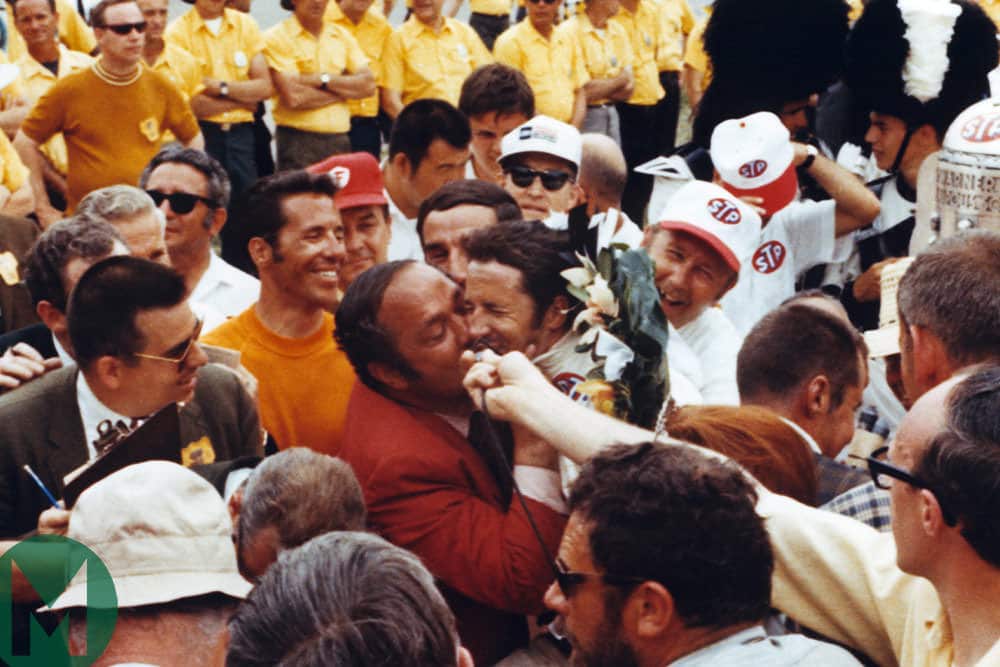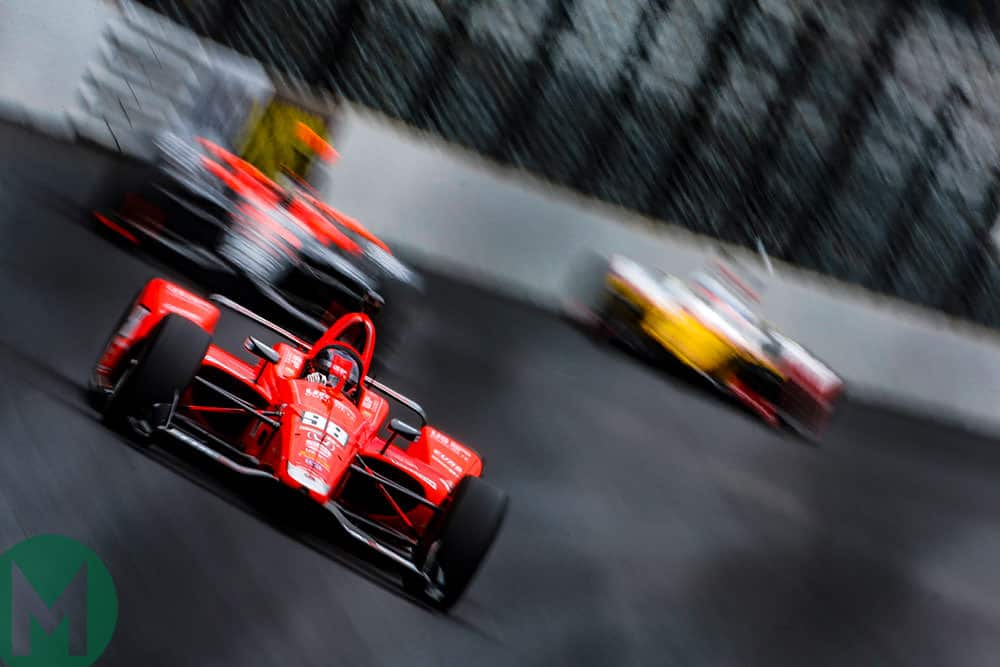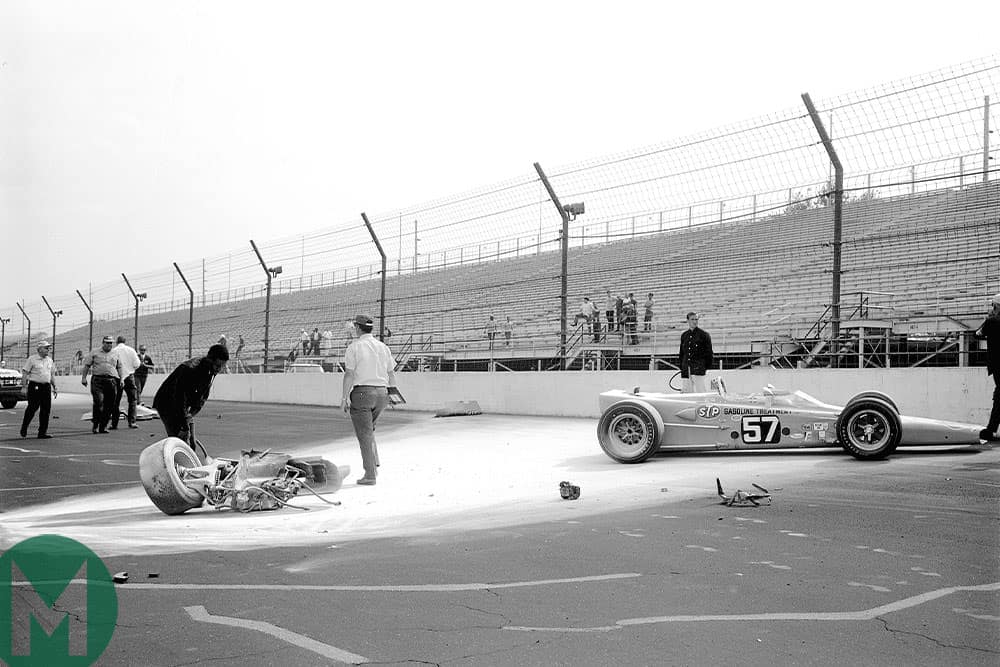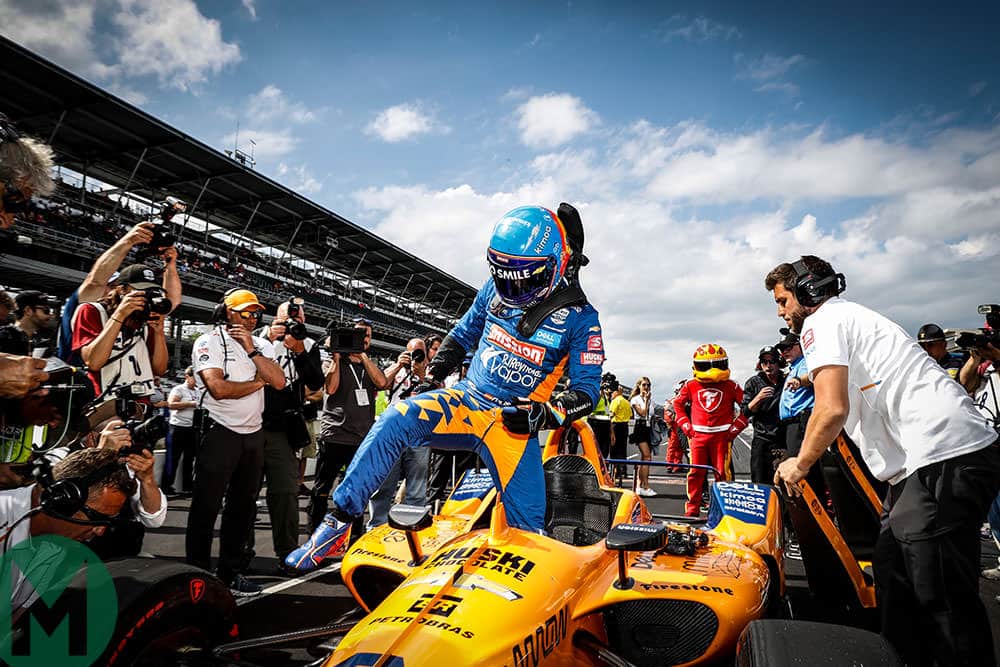
Mick Schumacher says IndyCar is racing 'as it should be'
Mick Schumacher says he's looking forward to making a difference in super-competitive IndyCar – and says the risk is all part of the fun
Mario Andretti looks back at his sole Indianapolis 500 win – 50 years ago in 1969 – and shows that Indianapolis has some lessons for McLaren and Fernando Alonso

Mario Andretti celebrates the 1969 Indy 500 victory with Andy Granatelli Photo: IMS
Fifty years after his Indianapolis 500 victory, Mario Andretti still knows the circuit better than anyone. In fact, the 79-year-old will turn more laps of the circuit during the Month of May than any current IndyCar driver.
And having entered the race 29 times, finished on the lead lap just five times and won it only once –in 1969 – he knows what it takes to succeed at Indianapolis Motor Speedway: something that Fernando Alonso, his team and fans should take heed of.
Andretti last raced at the Indy 500 in 1994 but his schedule still revolves around the circuit.
Each May, he effectively moves from his hometown of Nazareth, Pennsylvania to an Indianapolis hotel, and takes the wheel of a two-seater Indycar, allowing passengers to share the sensation of being whisked around the oval at 200mph.
“The schedule for me is 27 hours and 15 minutes in a two-seater for May. That’s what I live for, what I enjoy – and I go incredibly fast in the two-seater,” says Andretti.
“With my daughter, who is quite petite, I gave three laps and one at a 207-mph average. And I am at the limit at that speed because the cornering speed is pretty much flat[-out] all the way round. It’s fun.”
The veteran reveals that his preparation and commitment is similar to that of his racing days – these aren’t just joyrides.
“For me, it keeps me in the element and I evaluate the tyres. For 33 passengers [who will get a ride on May 27] I go through 10 sets of tyres. I have to keep them really fresh, just like qualifying, as I’m right at the limit.”
He also tests an Indycar run by his son Michael. Although Mario doesn’t talk about that too much, it’s clear that his decades of experience give the team some sort of edge.
“I have a better feel than the current drivers,” he says. “Modern drivers today rely too much on what the engineers tell them and computers and data… that’s absolutely a great tool to have, but some of the practical side is lacking and sometimes I can shed some light in that area because I have a pretty good feel.
He even gives grandson Marco, who qualified 10th for this year’s Indy 500, feedback on the track surface and Firestone tyre compounds.

Marco Andretti runs a Mario Andretti 1969 tribute livery this month Photo: Motorsport Images
Mario – who entered the race 29 times – relies on tried and tested methods at Indy. He does things the old-school way.
“I drive by the windsocks at Turn One and Turn Three and that can change your entry dramatically, and so forth, and you have to be aware of that because it can catch you out.
“Believe me, the slightest mistake or miscalculation at those speeds can be huge. So it gets your attention, I can tell you that.
“Even in the two-seater I just brushed the wall. Whoever’s sitting behind me has no idea,” he says, chuckling.
“Last year I think I touched the wall when there was a crosswind… But I blamed another driver for it: ‘It was Davey Hamilton! I saw him crash!’”, he continues, now laughing as he thinks back at his scrape with the wall with the blissfully unaware passenger in the back.
Like Alonso, who was bumped from the top-33 in qualifying last weekend, Andretti had his own brush with failure. Well, many. So many that his string of bad luck was dubbed the “Andretti curse”. But his bounce back is inspiring.
His quest for Indy supremacy started well. On Andretti’s 1965 debut, he qualified fourth and finished third behind Jim Clark and Parnelli Jones – not bad going for an Italian whose only knowledge of American racing when he arrived in the States came from the 1951 movie To Please A Lady, which he saw when he was 11.
Only by faking his age and lying about his Formula Junior experience in native Italy did he even get the chance to race in America…
More
He sat on pole in 1966 and ‘67. But in ‘66 oil spewed from Andretti’s car and he was black-flagged while leading Clark; a year later he ended up losing a wheel and AJ Foyt took the win; the following year his car needed an engine change before qualifying then succumbed to another failure on lap two of the race.
Things were looking even less promising in 1969. STP CEO Andy Granatelli’s team had entered three cars for the race – two Lotuses and the Brawner Hawk. Andretti’s four-wheel-drive Lotus 64 shed a wheel at Turn Four and burst into flames with him at the wheel. And as the first qualifying session had been rained out, there was only one weekend left for the 33 drivers to make the field.
Motor Sport’s report from the Archive said: “Andretti escaped with second degree burns to part of his face but the very next morning, his blistered skin still painful, he was back on the track in his back-up [Brawner] Hawk trying to achieve in two days what had taken two weeks in the Lotus.”
Mario Andretti recalls that his car, the Brawner Hawk, was only really intended to keep the garage warm. The Lotus 46 was supposed to be the car that would bring Granatelli success at Indy after years of trying.
“Granatelli tried so hard with the turbine car, and he failed – came close – and it looked like it was going to be another very disappointing month for him,” explains Andretti.

The aftermath of Mario Andretti’s crash in practice for the 1969 Indy 500 Photo: IMS
“This [Brawner Hawk] was entered as a ‘space car’, just to get another garage really. Many teams were entering three cars and racing just one, as you get three garages. So, as you can see, the accident with the Lotus happened two days before the final qualifying weekend.
“I probably would’ve sat on pole in a Lotus because I was pretty much quickest every day and I had that car working really well, but they had some failures – suspension failures – and one was a halfshaft in the front that wiped out the suspension. We didn’t know how critical that was.
“It’s good that I [crashed] because that showed the weakness on the wheel hub,” he maintains.
Once the accident happened, Colin Chapman realised that the suspension components on the Lotus 46 were critical, and Mario Andretti was left to qualify in the Brawner. To his “pleasant surprise,” he made the front row.
“In the race, we knew we were going to have some cooling problems with the oil,” he explains, “because the way it was designed was very inefficient. To overcome that, for the race we put an extra oil collar above the roll bar though it would create some considerable drag.”
Crucially, the extra oil cooler wasn’t fitted for qualifying, and as a result, it was removed by the scrutineering team.
“I think our chief mechanic should probably have reread the rules a little bit closer,” says Mario. “But I took the lead right at the start, and after seven laps my oil temperature was up to 170 degrees Fahrenheit (76.67deg C) and I figured, ‘holy crap’.
Alonso didn’t waste any time and his approach was absolutely commendable, it was fabulous.
“So I eased off just a bit and Foyt and [Roger] McCluskey went by me and I followed them in third place and in fact, I don’t think I was ever higher than third [for almost] the whole race.
“And I just figured, well if it’s going to go, it’s going to go, so I just kept driving and the thing just stayed together for me.
“I had quite a bit of a fight with Lloyd Ruby but I had his measure because he and I traded places a couple of times. I would let him lead and ease off a bit and then I would overtake him – and then he dropped out.”
It was Foyt who fell back first as his turbocharger broke, and then it was Ruby’s turn as the refuelling hose ripped the fuel bladder – he had pulled away from the pits too early. Andretti had the lead.
“Then I had the measure of the rest of the field and kept running. Towards the last part, I had a lap and a half lead on Dan Gurney and I could see him, so I stayed where I was – and the car just lasted.
“It was a miracle, quite honestly, because even the gearbox – [crew chief] Jim McGee told me – wouldn’t have made a couple more laps. I was hearing a lot of, a lot of rustiness in the drivetrain. All the bearings were gone, the oil was all dried up…”
“So it was my day I guess, everything just worked out, and it was a very very satisfying win as you can imagine, for many many reasons.
“But for him it was everything and then to be able to bring him the first victory was incredibly, incredibly satisfying. There was so much emotion and euphoria.
“That was really, really, something to remember,” says Andretti.
Days after this interview, Alonso failed to qualify for Indy, ending his hope of claiming motor racing’s unofficial triple crown (victory at the Monaco Grand Prix, Le Mans 24 Hours and Indy 500) for this year. It was followed by reports of McLaren’s disorganisation, which ultimately led to IndyCar project leader Bob Fernley leaving.
Andretti’s (and Granatelli’s) string of defeats that led up to the 1969 win is a point of inspiration for Alonso: Indianapolis provides setback after setback, but it rewards perseverance as much as sheer speed.
Alonso has already proved the latter, given his 2017 drive for Andretti Autosport that ended with his Honda engine failing 21 laps from the end of the race.
“His mindset was not just to come here and race but to come here and try to win. He didn’t waste any time and his approach was absolutely commendable, it was fabulous,” says Andretti.
“He’s looking at trying to emulate what Graham Hill did [in winning the triple crown]. And why not? He’s deriving a lot of satisfaction from that… when he came two years ago, he was loaded for bear.”

Alonso bows out of the 2019 Indy 500 Photos: Motorsport Images
Aiming for the most prestigious target perhaps, but this year’s McLaren/Carlin relationship was never going to be as powerful as a McLaren papaya-coloured Andretti racer.
“With Michael [Andretti, Mario’s son] you had the luxury of having four other drivers on the team and engineers and you knew exactly what everybody else was doing so he could be very confident about the set-up of the car.
“I remember when [Alonso] first arrived here just to have a first taste of it, Marco went out and laid down a few laps for him before to make sure the car was all proper and safe. You imagine as a driver what a luxury that is, to go somewhere where it’s very, very new and unusual and yet know that the car is capable of.
“And he was confident, even slightly over-confident during the race and it was like ‘oh my god.’ But he was loaded for bear, he was really, really at the peak and it would’ve been interesting if he didn’t have an engine failure [to see] how it would’ve ended up.”
Indianapolis may be an unforgiving place, 100,000 fans and 32 others bearing down on you as the walls close in, but Mario Andretti maintains that the IndyCar contingent welcomed Alonso “with open arms,” and that Andretti Autosport wanted the two-time F1 champion back on board. McLaren’s new F1 engine deal with Renault, replacing the Honda partnership, blocked this possibility.
More
“Because of the Honda situation,” says Andretti, “Michael could not have McLaren part of the team as before. And now they’re on their own.”
Andretti’s triumph over adversity came not only from perseverance, but the love of the sport, and it paid off as even with blisters on his back from the hot oil, and burns on his face, he celebrated the big one five decades ago.
“You overlook all that. People asked how you’re feeling and I say, ‘I’m fine, let’s just get this damn thing going.’
“When you’re driven you’re driven and I think the passion and the love that you have for what you’re doing just overcomes the situation. Quite honestly I just wanted to get on with the job and see if I could pull it off and we did. After that, everything is fine.”
After qualifying, when the dejected Alonso climbed out of his McLaren, he said: “I prefer to be here, even 34th, than being at home like last year.”
It already seems like Alonso has learned the lessons of Indy.

Mick Schumacher says he's looking forward to making a difference in super-competitive IndyCar – and says the risk is all part of the fun

Mick Schumacher has followed the American Dream by heading to IndyCar: Can he match other F1 aces that have succeeded Stateside?

The McLaren vs Alex Palou court case has provided shock, intrigue and entertainment in equal measure – here are 12 fascinating things we've learnt from it so far

McLaren's court case against IndyCar champion Alex Palou has exposed the price that some drivers will pay to join a Formula 1 free practice session